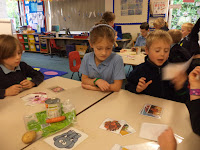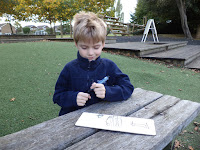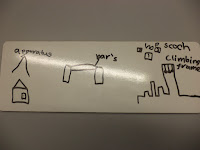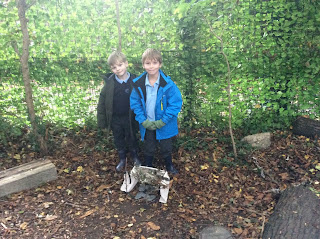Our Autumn term topic in Year 1 was ‘Myself’.
We began by looking at the similarities and differences
between people; we thought about the variety of personalities, appearance,
abilities and interests, and how we are all special. We acted out some naming
ceremonies which are held to welcome new babies, in both the Sikh and Christian
faiths.
Our focus on how we are all different helped us to recognise
that we may feel differently too. We
played a miming game, guessing – from their appearance and behaviour - how
someone might be feeling.
We used masks to share with the class about
situations which make us feel happy or sad. We listened carefully to each
other, tried to understand how other people might feel, and thought of ways in
which we could help others feel happy or avoid hurting their feelings.
Next we focused on our homes:
why they are important to us and what we do there, including special customs.
We learned about the weekly celebration of Shabbat in Jewish homes. We took
part in a story-enactment of when the Israelite people travelled on their long
journey to a new home.
We learned how this is remembered by Jewish families in
their Shabbat meal, and we acted it out, focusing on the symbols used. Jewish
people spent many years without a proper home: no wonder they see their home
and family as so important nowadays!
Many of our families have
their own special traditions: we shared with each other our own family customs
and ways of dong things. We then learned about the Hindu festival of Raksha
Bandhan, when brothers and sisters express their family ties and love by
exchanging presents and bracelets called rakhi.
In October, Jewish people were celebrating their New Year at
Rosh Hashana. So we learned about how they say sorry for wrong things they have
done, and try to make a fresh start. We studied various items which are used at
Rosh Hashana, and made suggestions as to how they might help Jews to say
‘sorry’. We then found out how each of them is used.
We tied a red ribbon to
our (child)scape-goat and pretended to send her off into the desert, taking
away all our bad things!
We said ‘sorry’ for our own wrong behaviour as we
threw breadcrumbs into the ‘river’ to be washed away. Then, with a blow on the
shofar horn, we wished each other a ‘sweet New Year’ with apple dipped in
honey.
Another aspect of our ‘Myself’ topic was ‘My Day’. After considering our own
daily activities, we found out how important it is for Muslims to pray five
times each day. We studied a Muslim prayer mat and Qiblah compass, and learned
how they are used. We then acted out how a Muslim’s day might be, including
prayer times.
After half-term, we focused on the theme of ‘Belonging’. First, we thought about the groups to which we belong: what makes them special; activities, rules and customs we share; and how we feel being part of them. We enjoyed playing some games for small and large groups, and reviewed the ways we ensured everyone was able to feel included.
We then looked at signs
and symbols of belonging. We played a game to help us sort out information
signs from symbols with a special meaning, then designed our own personal coat
of arms to represent aspects of our personality and interests. This led us on
to learning about faith symbols.
As we approached the Christmas holiday, we moved to learning
about the Bible story behind all the festivities. For Christians, the birth of Jesus
was very special.
In January, we are starting our Spring Term topic, focusing
on ‘New Life’
In Year 2, our Autumn term topic was ‘Special Times’.
We started by looking back over our lives to identify
special ‘milestones’ so far,
including stages in our growth and abilities, and special events. We wondered
what the future might hold for us, and made suggestions of possible milestones
we would like to have as we grow up!
In the RE lessons which followed, we focused on individual
times which are special for people of different faiths.
We began by sharing our experiences of different types of wedding. Some of us have even had
important roles, such as bridesmaids or page-boys. We acted out a Sikh wedding
then a Christian wedding, finding out about similarities and differences
between the ceremonies, and about promises couples might make to each other.
One of the most important ‘special times’ for Muslims is the
month of Ramadan, which ends in the
festival of Eid Ul-Fitr. We imagined
what it must be like to go without food during daylight hours, and found out
how Muslims use their time of fasting to help them think about those less well
off than themselves. We also learned how they pray, study the Qur’an and go to
the mosque. We found out whether it was dark enough to eat, by checking whether
we could distinguish between black and white threads! In groups, we
brainstormed words for how we feel when we are waiting for a special event,
such as a birthday; then we imagined how a Muslim child might feel when
watching for the new moon which signifies the time to begin Eid celebrations.
The next ‘special time’ we learned about was the regular
shared meal at a Sikh langar. We
started with a challenge: two children were given marshmallows to eat, but
there were some difficult rules! They had to use long-handled cutlery held at
the very ends! It seemed as though they would never get to taste the
marshmallows, but then one child suggested that they should feed each other –
and it worked! This helped us understand the importance of sharing.
Four of our
class were then invited to sit at a beautifully set-out meal table, while the
rest of us had to sit on the floor with old beakers and boring serviettes. We
discussed how we felt about this and concluded that it wasn’t fair! We learned
that Sikhs all sit on the floor for meals at their langar, and everyone is
welcome to share in a free meal there. Everyone is considered equal, whatever
their race, religion, wealth or position.
We then learned about the Christian festival of Harvest. Some children shared their own
experiences of taking part in Harvest Festivals. Christians use Harvest as a
special time of saying ‘thank you’ so, in groups, we brainstormed ideas of
things, in addition to food, for which we are grateful. We learned that
Christians believe God wants them to remember to thank him for good gifts. We
decided that one way of showing we are grateful is by sharing what we have with
others, just as Christians share the food from their Harvest Festivals.
Next, we focused on the Jewish festival of Sukkot, which can also be seen as a form of harvest festival. First, we played Kim’s
Game to help us consider our strategies for remembering things. We told each
other about mementoes we have at home, and discussed how celebrations and times
of commemoration can help us. Outside in the playground, we went on a memory
walk, noting down significant items which would serve as mementoes later. We
explained to each other how they would remind us of Crabtree Infants’ School,
in years to come. We learned how Jewish people eat their meals in a sukkah,
during the festival of Sukkot, to help them remember how God looked after their
ancestors when they lived in tents during their long journey to their new
homeland. Then, in Woodland Learning, we made our own model sukkot.
During Autumn, there are several Festivals of Light, when different faiths use the symbol of light
to represent ideas about God, goodness and hope. We worked with partners,
thinking of words and feelings we associate with both ‘light’ and ‘dark’, then
wrote our own poems based on those symbols.
We learned that the Hindu and Sikh Festival, Divali, is a Festival of Light. First, we heard the story of Rama and
Sita and discussed how the characters and events symbolise the victory of good
over evil. After thinking of good and bad things which happen nowadays, we
considered how we could help to bring ‘light’ to our world. We also found out about some of the Divali customs
and celebrations which take place each year.
Symbols were very helpful when we learned about the very important time of remembering, which takes place each November, on Remembrance Day. Having discussed the background and customs of Remembrance Day, we focused on the hope for peace. We looked carefully at a selection of pictures illustrating some words of the prophet Isaiah, from the Bible. We learned about an artist, Edward Hicks, who included Isaiah’s hopes in his paintings. We then made our own pictures, based on the same ideas, and discussed what we could do to help create peace in our world. Some of us wrote our own poems of hope for a more peaceful world.
Our next Festival of Light was Hanukkah. We related what we had learned about the symbolism of
light to the Hanukkah story, and suggested meanings for the various customs -
such as the 9-branched hanukiah and the eating of latkes cooked in oil. We then
made our own dreidl spinners, so that we too could play the game enjoyed by
Jewish children during Hanukkah.
Next, we learned about the Christian time of Advent. We thought about how we get ready for important events, then looked at some Advent calendars and a notched advent candle and talked about how they might be used by Christians. We thought about people who might have looked forward to Jesus’ coming, and guessed which of these might be represented by the four red candles on an Advent ring. We then lit the four candles, one by one, as we heard about each of the people remembered by Christians on the four Sundays in Advent. We weren’t able to light the white candle in the centre, though, as we weren’t in school on Christmas Day!
In preparation for our Christmas Play, we learned about the
first Christmas and the importance of Jesus’ birth to Christians. Our study of
the symbols of light and dark, over the last few weeks, has helped us to
understand why Christians describe Jesus as ‘the Light of the World’.
In January, we will be starting our Spring Term topic,
focusing on Special People.
Take a look at the Reception Blog for Nov 4th
to find out what we have been learning about Divali. We heard a Hindu story
about Rama and Sita, and also made clay diva pots, which we then painted and decorated.
The following week, we also thought about our other celebrations which take
place through the year.
Also have a look on the Reception Blog for pictures of all
our Christmas activities!

































































































